Strategic Analysis: Tools and Techniques for Weetabix Limited
VerifiedAdded on 2023/06/07
|17
|4639
|102
AI Summary
This report analyzes Weetabix Limited's strategic positioning using various tools and techniques. It includes an analysis of the company's differentiation strategy, stakeholder analysis, PEST analysis, and Porter's Five Forces. The report also explores external factors affecting the company's profitability.
Contribute Materials
Your contribution can guide someone’s learning journey. Share your
documents today.
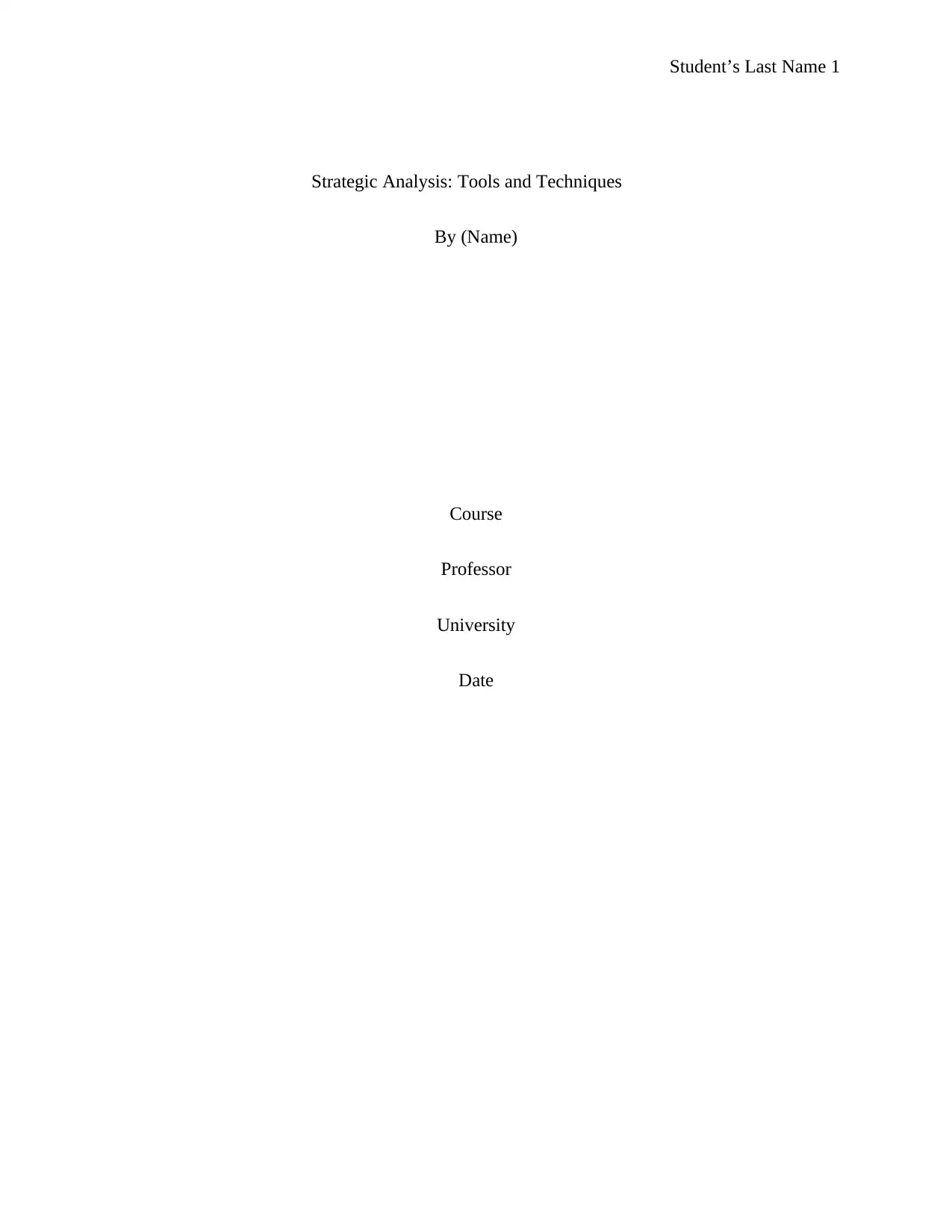
Student’s Last Name 1
Strategic Analysis: Tools and Techniques
By (Name)
Course
Professor
University
Date
Strategic Analysis: Tools and Techniques
By (Name)
Course
Professor
University
Date
Secure Best Marks with AI Grader
Need help grading? Try our AI Grader for instant feedback on your assignments.
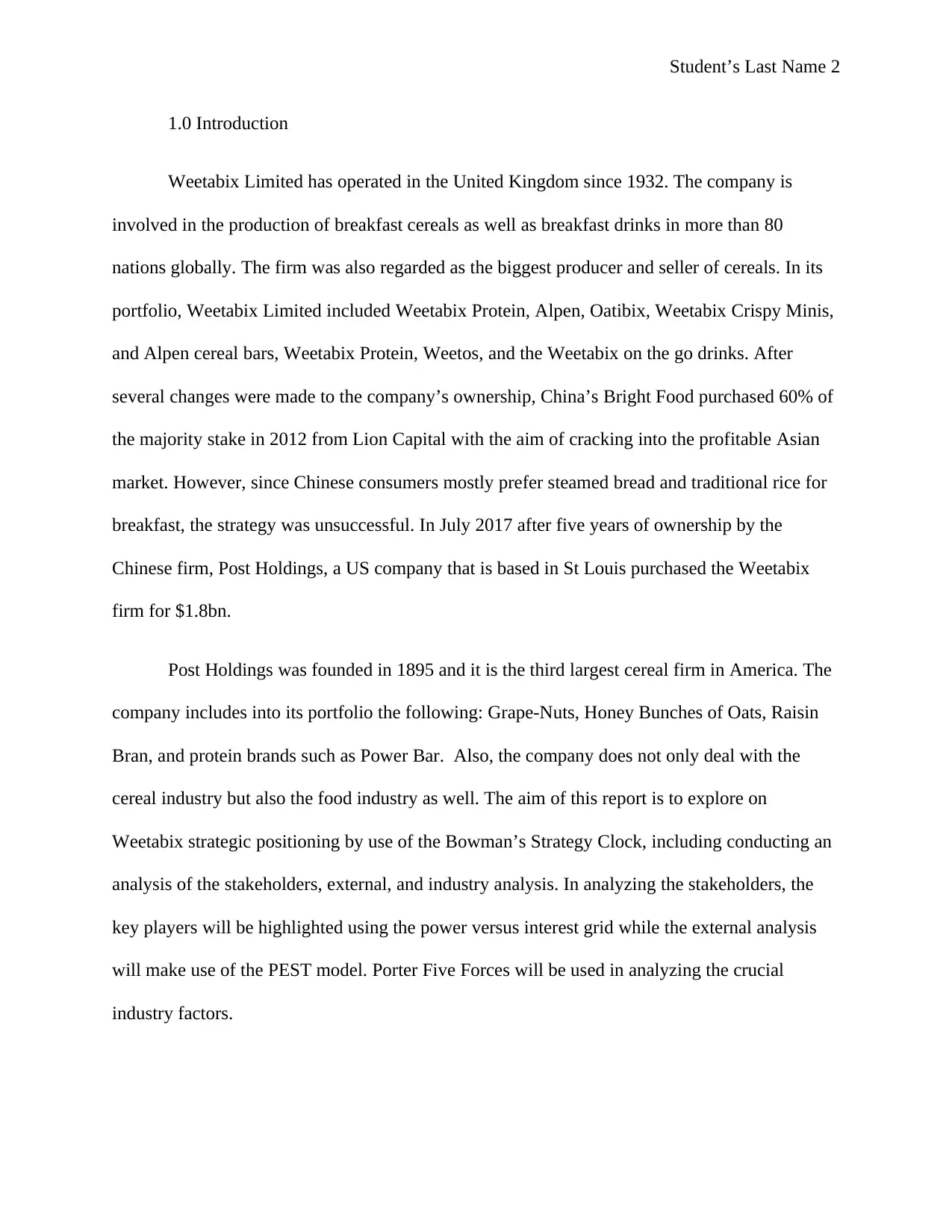
Student’s Last Name 2
1.0 Introduction
Weetabix Limited has operated in the United Kingdom since 1932. The company is
involved in the production of breakfast cereals as well as breakfast drinks in more than 80
nations globally. The firm was also regarded as the biggest producer and seller of cereals. In its
portfolio, Weetabix Limited included Weetabix Protein, Alpen, Oatibix, Weetabix Crispy Minis,
and Alpen cereal bars, Weetabix Protein, Weetos, and the Weetabix on the go drinks. After
several changes were made to the company’s ownership, China’s Bright Food purchased 60% of
the majority stake in 2012 from Lion Capital with the aim of cracking into the profitable Asian
market. However, since Chinese consumers mostly prefer steamed bread and traditional rice for
breakfast, the strategy was unsuccessful. In July 2017 after five years of ownership by the
Chinese firm, Post Holdings, a US company that is based in St Louis purchased the Weetabix
firm for $1.8bn.
Post Holdings was founded in 1895 and it is the third largest cereal firm in America. The
company includes into its portfolio the following: Grape-Nuts, Honey Bunches of Oats, Raisin
Bran, and protein brands such as Power Bar. Also, the company does not only deal with the
cereal industry but also the food industry as well. The aim of this report is to explore on
Weetabix strategic positioning by use of the Bowman’s Strategy Clock, including conducting an
analysis of the stakeholders, external, and industry analysis. In analyzing the stakeholders, the
key players will be highlighted using the power versus interest grid while the external analysis
will make use of the PEST model. Porter Five Forces will be used in analyzing the crucial
industry factors.
1.0 Introduction
Weetabix Limited has operated in the United Kingdom since 1932. The company is
involved in the production of breakfast cereals as well as breakfast drinks in more than 80
nations globally. The firm was also regarded as the biggest producer and seller of cereals. In its
portfolio, Weetabix Limited included Weetabix Protein, Alpen, Oatibix, Weetabix Crispy Minis,
and Alpen cereal bars, Weetabix Protein, Weetos, and the Weetabix on the go drinks. After
several changes were made to the company’s ownership, China’s Bright Food purchased 60% of
the majority stake in 2012 from Lion Capital with the aim of cracking into the profitable Asian
market. However, since Chinese consumers mostly prefer steamed bread and traditional rice for
breakfast, the strategy was unsuccessful. In July 2017 after five years of ownership by the
Chinese firm, Post Holdings, a US company that is based in St Louis purchased the Weetabix
firm for $1.8bn.
Post Holdings was founded in 1895 and it is the third largest cereal firm in America. The
company includes into its portfolio the following: Grape-Nuts, Honey Bunches of Oats, Raisin
Bran, and protein brands such as Power Bar. Also, the company does not only deal with the
cereal industry but also the food industry as well. The aim of this report is to explore on
Weetabix strategic positioning by use of the Bowman’s Strategy Clock, including conducting an
analysis of the stakeholders, external, and industry analysis. In analyzing the stakeholders, the
key players will be highlighted using the power versus interest grid while the external analysis
will make use of the PEST model. Porter Five Forces will be used in analyzing the crucial
industry factors.
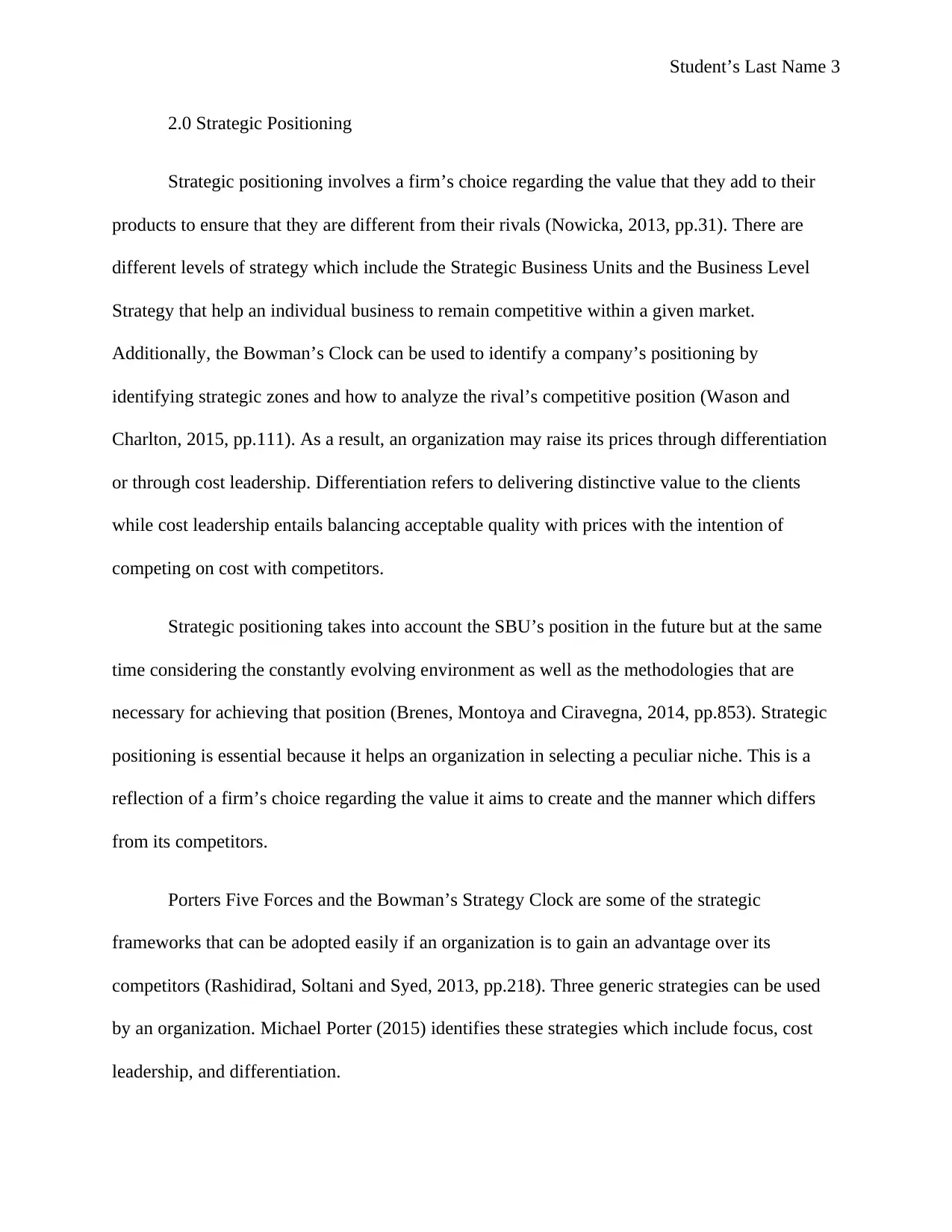
Student’s Last Name 3
2.0 Strategic Positioning
Strategic positioning involves a firm’s choice regarding the value that they add to their
products to ensure that they are different from their rivals (Nowicka, 2013, pp.31). There are
different levels of strategy which include the Strategic Business Units and the Business Level
Strategy that help an individual business to remain competitive within a given market.
Additionally, the Bowman’s Clock can be used to identify a company’s positioning by
identifying strategic zones and how to analyze the rival’s competitive position (Wason and
Charlton, 2015, pp.111). As a result, an organization may raise its prices through differentiation
or through cost leadership. Differentiation refers to delivering distinctive value to the clients
while cost leadership entails balancing acceptable quality with prices with the intention of
competing on cost with competitors.
Strategic positioning takes into account the SBU’s position in the future but at the same
time considering the constantly evolving environment as well as the methodologies that are
necessary for achieving that position (Brenes, Montoya and Ciravegna, 2014, pp.853). Strategic
positioning is essential because it helps an organization in selecting a peculiar niche. This is a
reflection of a firm’s choice regarding the value it aims to create and the manner which differs
from its competitors.
Porters Five Forces and the Bowman’s Strategy Clock are some of the strategic
frameworks that can be adopted easily if an organization is to gain an advantage over its
competitors (Rashidirad, Soltani and Syed, 2013, pp.218). Three generic strategies can be used
by an organization. Michael Porter (2015) identifies these strategies which include focus, cost
leadership, and differentiation.
2.0 Strategic Positioning
Strategic positioning involves a firm’s choice regarding the value that they add to their
products to ensure that they are different from their rivals (Nowicka, 2013, pp.31). There are
different levels of strategy which include the Strategic Business Units and the Business Level
Strategy that help an individual business to remain competitive within a given market.
Additionally, the Bowman’s Clock can be used to identify a company’s positioning by
identifying strategic zones and how to analyze the rival’s competitive position (Wason and
Charlton, 2015, pp.111). As a result, an organization may raise its prices through differentiation
or through cost leadership. Differentiation refers to delivering distinctive value to the clients
while cost leadership entails balancing acceptable quality with prices with the intention of
competing on cost with competitors.
Strategic positioning takes into account the SBU’s position in the future but at the same
time considering the constantly evolving environment as well as the methodologies that are
necessary for achieving that position (Brenes, Montoya and Ciravegna, 2014, pp.853). Strategic
positioning is essential because it helps an organization in selecting a peculiar niche. This is a
reflection of a firm’s choice regarding the value it aims to create and the manner which differs
from its competitors.
Porters Five Forces and the Bowman’s Strategy Clock are some of the strategic
frameworks that can be adopted easily if an organization is to gain an advantage over its
competitors (Rashidirad, Soltani and Syed, 2013, pp.218). Three generic strategies can be used
by an organization. Michael Porter (2015) identifies these strategies which include focus, cost
leadership, and differentiation.
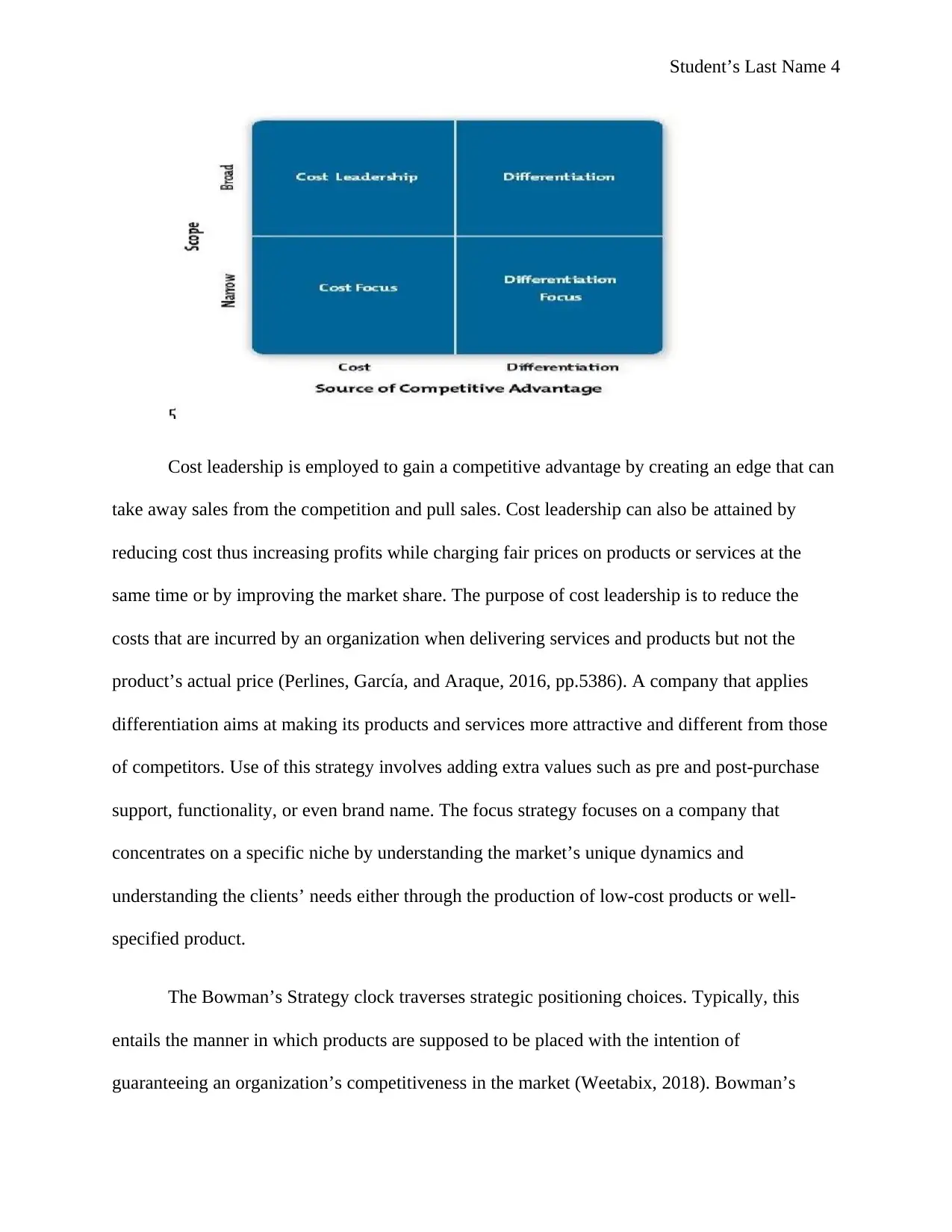
Student’s Last Name 4
Cost leadership is employed to gain a competitive advantage by creating an edge that can
take away sales from the competition and pull sales. Cost leadership can also be attained by
reducing cost thus increasing profits while charging fair prices on products or services at the
same time or by improving the market share. The purpose of cost leadership is to reduce the
costs that are incurred by an organization when delivering services and products but not the
product’s actual price (Perlines, García, and Araque, 2016, pp.5386). A company that applies
differentiation aims at making its products and services more attractive and different from those
of competitors. Use of this strategy involves adding extra values such as pre and post-purchase
support, functionality, or even brand name. The focus strategy focuses on a company that
concentrates on a specific niche by understanding the market’s unique dynamics and
understanding the clients’ needs either through the production of low-cost products or well-
specified product.
The Bowman’s Strategy clock traverses strategic positioning choices. Typically, this
entails the manner in which products are supposed to be placed with the intention of
guaranteeing an organization’s competitiveness in the market (Weetabix, 2018). Bowman’s
Cost leadership is employed to gain a competitive advantage by creating an edge that can
take away sales from the competition and pull sales. Cost leadership can also be attained by
reducing cost thus increasing profits while charging fair prices on products or services at the
same time or by improving the market share. The purpose of cost leadership is to reduce the
costs that are incurred by an organization when delivering services and products but not the
product’s actual price (Perlines, García, and Araque, 2016, pp.5386). A company that applies
differentiation aims at making its products and services more attractive and different from those
of competitors. Use of this strategy involves adding extra values such as pre and post-purchase
support, functionality, or even brand name. The focus strategy focuses on a company that
concentrates on a specific niche by understanding the market’s unique dynamics and
understanding the clients’ needs either through the production of low-cost products or well-
specified product.
The Bowman’s Strategy clock traverses strategic positioning choices. Typically, this
entails the manner in which products are supposed to be placed with the intention of
guaranteeing an organization’s competitiveness in the market (Weetabix, 2018). Bowman’s
Secure Best Marks with AI Grader
Need help grading? Try our AI Grader for instant feedback on your assignments.
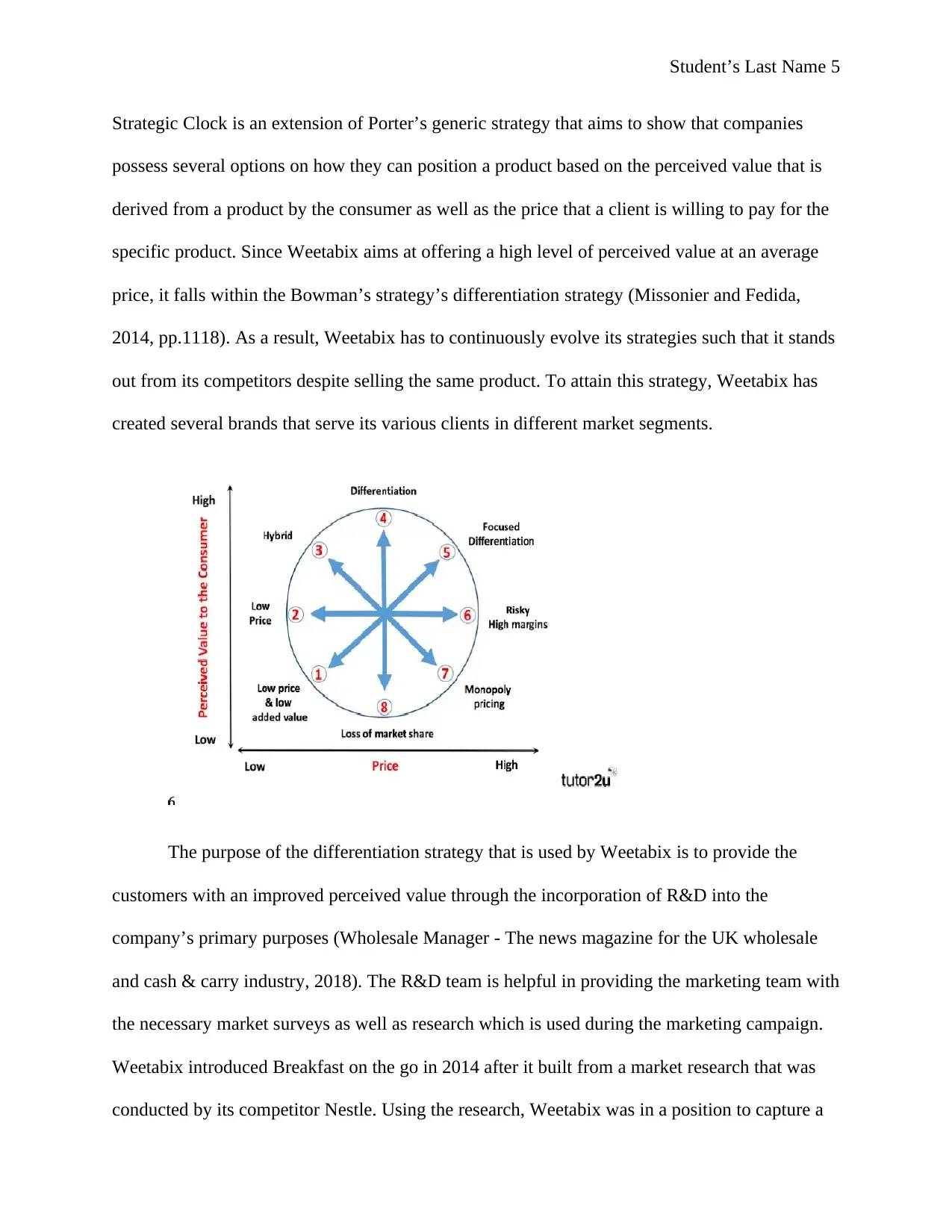
Student’s Last Name 5
Strategic Clock is an extension of Porter’s generic strategy that aims to show that companies
possess several options on how they can position a product based on the perceived value that is
derived from a product by the consumer as well as the price that a client is willing to pay for the
specific product. Since Weetabix aims at offering a high level of perceived value at an average
price, it falls within the Bowman’s strategy’s differentiation strategy (Missonier and Fedida,
2014, pp.1118). As a result, Weetabix has to continuously evolve its strategies such that it stands
out from its competitors despite selling the same product. To attain this strategy, Weetabix has
created several brands that serve its various clients in different market segments.
The purpose of the differentiation strategy that is used by Weetabix is to provide the
customers with an improved perceived value through the incorporation of R&D into the
company’s primary purposes (Wholesale Manager - The news magazine for the UK wholesale
and cash & carry industry, 2018). The R&D team is helpful in providing the marketing team with
the necessary market surveys as well as research which is used during the marketing campaign.
Weetabix introduced Breakfast on the go in 2014 after it built from a market research that was
conducted by its competitor Nestle. Using the research, Weetabix was in a position to capture a
Strategic Clock is an extension of Porter’s generic strategy that aims to show that companies
possess several options on how they can position a product based on the perceived value that is
derived from a product by the consumer as well as the price that a client is willing to pay for the
specific product. Since Weetabix aims at offering a high level of perceived value at an average
price, it falls within the Bowman’s strategy’s differentiation strategy (Missonier and Fedida,
2014, pp.1118). As a result, Weetabix has to continuously evolve its strategies such that it stands
out from its competitors despite selling the same product. To attain this strategy, Weetabix has
created several brands that serve its various clients in different market segments.
The purpose of the differentiation strategy that is used by Weetabix is to provide the
customers with an improved perceived value through the incorporation of R&D into the
company’s primary purposes (Wholesale Manager - The news magazine for the UK wholesale
and cash & carry industry, 2018). The R&D team is helpful in providing the marketing team with
the necessary market surveys as well as research which is used during the marketing campaign.
Weetabix introduced Breakfast on the go in 2014 after it built from a market research that was
conducted by its competitor Nestle. Using the research, Weetabix was in a position to capture a
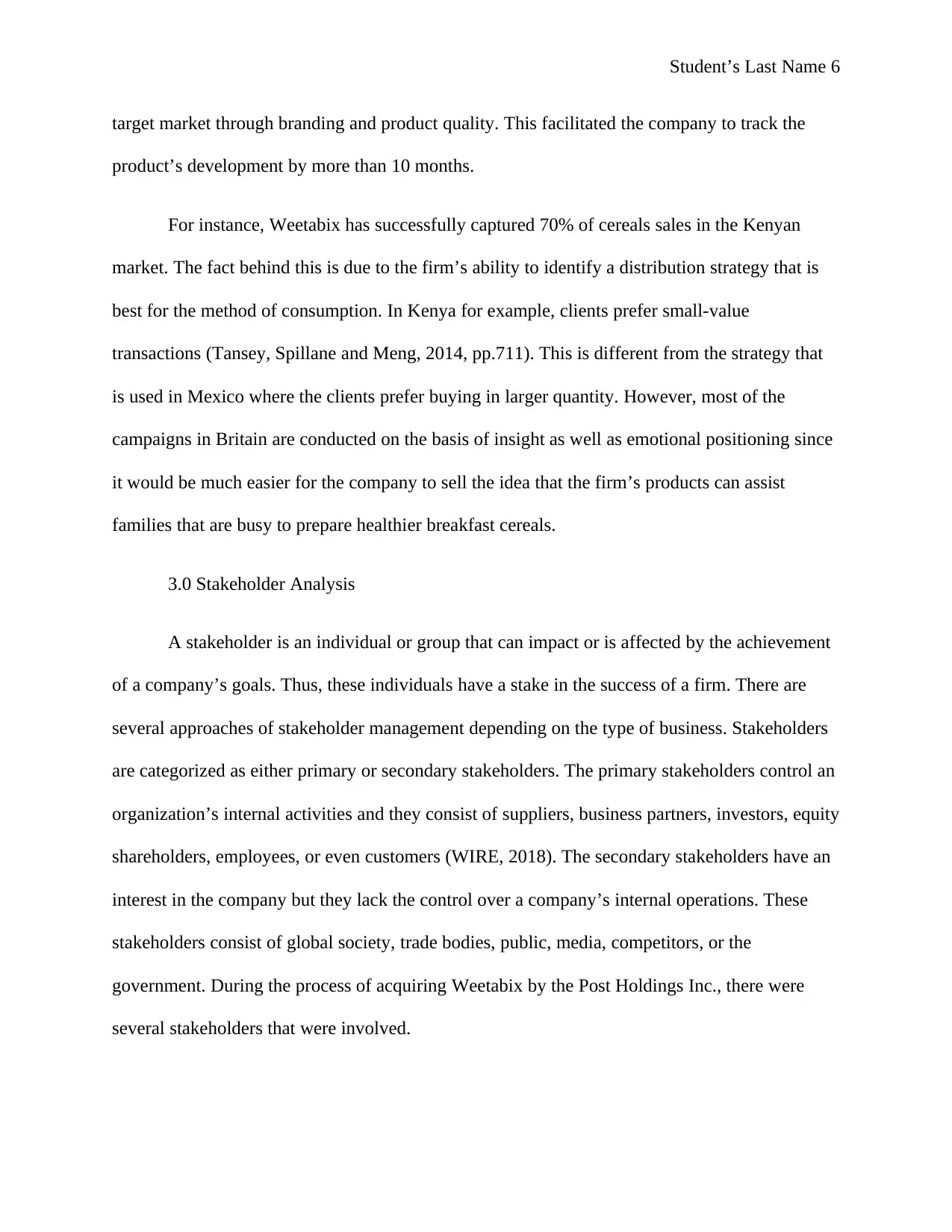
Student’s Last Name 6
target market through branding and product quality. This facilitated the company to track the
product’s development by more than 10 months.
For instance, Weetabix has successfully captured 70% of cereals sales in the Kenyan
market. The fact behind this is due to the firm’s ability to identify a distribution strategy that is
best for the method of consumption. In Kenya for example, clients prefer small-value
transactions (Tansey, Spillane and Meng, 2014, pp.711). This is different from the strategy that
is used in Mexico where the clients prefer buying in larger quantity. However, most of the
campaigns in Britain are conducted on the basis of insight as well as emotional positioning since
it would be much easier for the company to sell the idea that the firm’s products can assist
families that are busy to prepare healthier breakfast cereals.
3.0 Stakeholder Analysis
A stakeholder is an individual or group that can impact or is affected by the achievement
of a company’s goals. Thus, these individuals have a stake in the success of a firm. There are
several approaches of stakeholder management depending on the type of business. Stakeholders
are categorized as either primary or secondary stakeholders. The primary stakeholders control an
organization’s internal activities and they consist of suppliers, business partners, investors, equity
shareholders, employees, or even customers (WIRE, 2018). The secondary stakeholders have an
interest in the company but they lack the control over a company’s internal operations. These
stakeholders consist of global society, trade bodies, public, media, competitors, or the
government. During the process of acquiring Weetabix by the Post Holdings Inc., there were
several stakeholders that were involved.
target market through branding and product quality. This facilitated the company to track the
product’s development by more than 10 months.
For instance, Weetabix has successfully captured 70% of cereals sales in the Kenyan
market. The fact behind this is due to the firm’s ability to identify a distribution strategy that is
best for the method of consumption. In Kenya for example, clients prefer small-value
transactions (Tansey, Spillane and Meng, 2014, pp.711). This is different from the strategy that
is used in Mexico where the clients prefer buying in larger quantity. However, most of the
campaigns in Britain are conducted on the basis of insight as well as emotional positioning since
it would be much easier for the company to sell the idea that the firm’s products can assist
families that are busy to prepare healthier breakfast cereals.
3.0 Stakeholder Analysis
A stakeholder is an individual or group that can impact or is affected by the achievement
of a company’s goals. Thus, these individuals have a stake in the success of a firm. There are
several approaches of stakeholder management depending on the type of business. Stakeholders
are categorized as either primary or secondary stakeholders. The primary stakeholders control an
organization’s internal activities and they consist of suppliers, business partners, investors, equity
shareholders, employees, or even customers (WIRE, 2018). The secondary stakeholders have an
interest in the company but they lack the control over a company’s internal operations. These
stakeholders consist of global society, trade bodies, public, media, competitors, or the
government. During the process of acquiring Weetabix by the Post Holdings Inc., there were
several stakeholders that were involved.
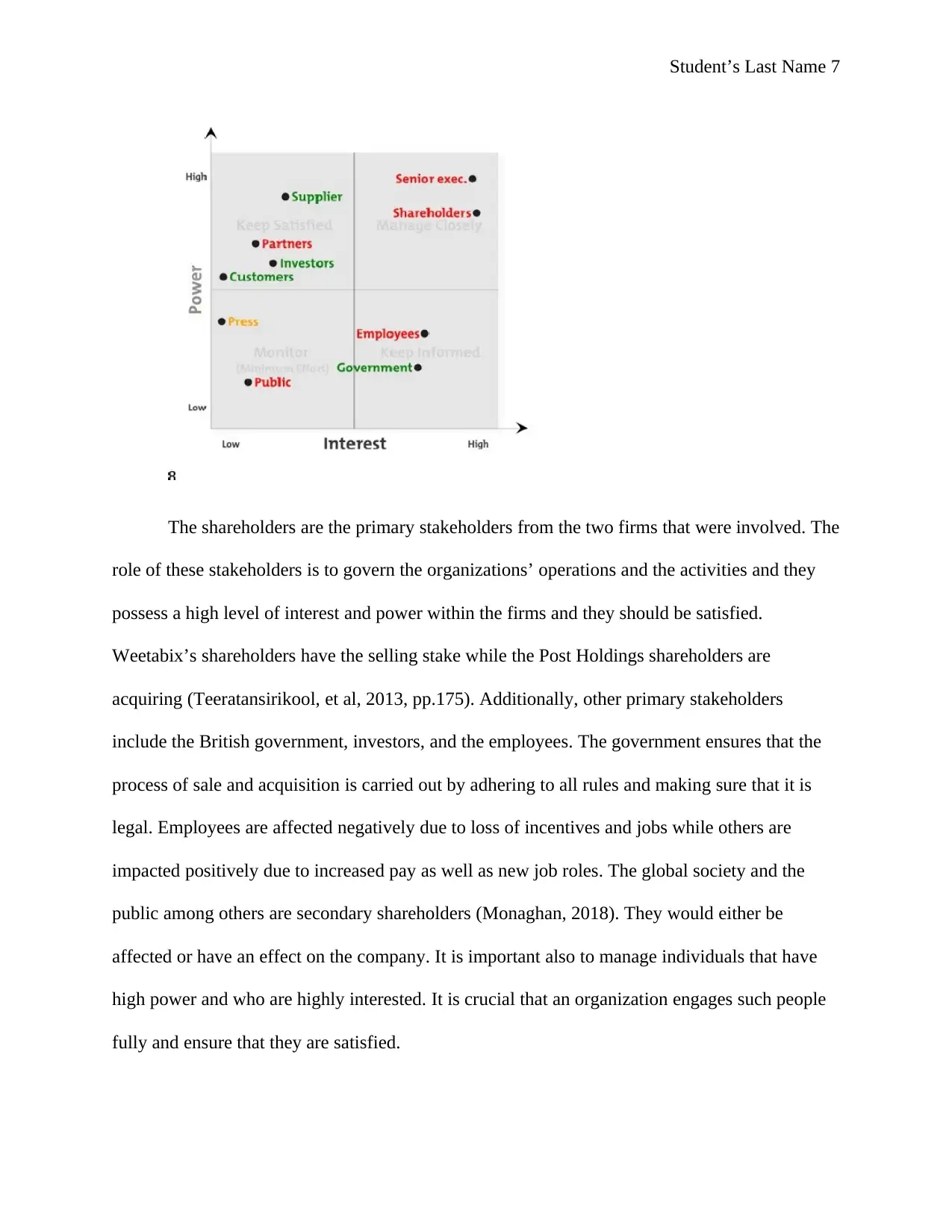
Student’s Last Name 7
The shareholders are the primary stakeholders from the two firms that were involved. The
role of these stakeholders is to govern the organizations’ operations and the activities and they
possess a high level of interest and power within the firms and they should be satisfied.
Weetabix’s shareholders have the selling stake while the Post Holdings shareholders are
acquiring (Teeratansirikool, et al, 2013, pp.175). Additionally, other primary stakeholders
include the British government, investors, and the employees. The government ensures that the
process of sale and acquisition is carried out by adhering to all rules and making sure that it is
legal. Employees are affected negatively due to loss of incentives and jobs while others are
impacted positively due to increased pay as well as new job roles. The global society and the
public among others are secondary shareholders (Monaghan, 2018). They would either be
affected or have an effect on the company. It is important also to manage individuals that have
high power and who are highly interested. It is crucial that an organization engages such people
fully and ensure that they are satisfied.
The shareholders are the primary stakeholders from the two firms that were involved. The
role of these stakeholders is to govern the organizations’ operations and the activities and they
possess a high level of interest and power within the firms and they should be satisfied.
Weetabix’s shareholders have the selling stake while the Post Holdings shareholders are
acquiring (Teeratansirikool, et al, 2013, pp.175). Additionally, other primary stakeholders
include the British government, investors, and the employees. The government ensures that the
process of sale and acquisition is carried out by adhering to all rules and making sure that it is
legal. Employees are affected negatively due to loss of incentives and jobs while others are
impacted positively due to increased pay as well as new job roles. The global society and the
public among others are secondary shareholders (Monaghan, 2018). They would either be
affected or have an effect on the company. It is important also to manage individuals that have
high power and who are highly interested. It is crucial that an organization engages such people
fully and ensure that they are satisfied.
Paraphrase This Document
Need a fresh take? Get an instant paraphrase of this document with our AI Paraphraser
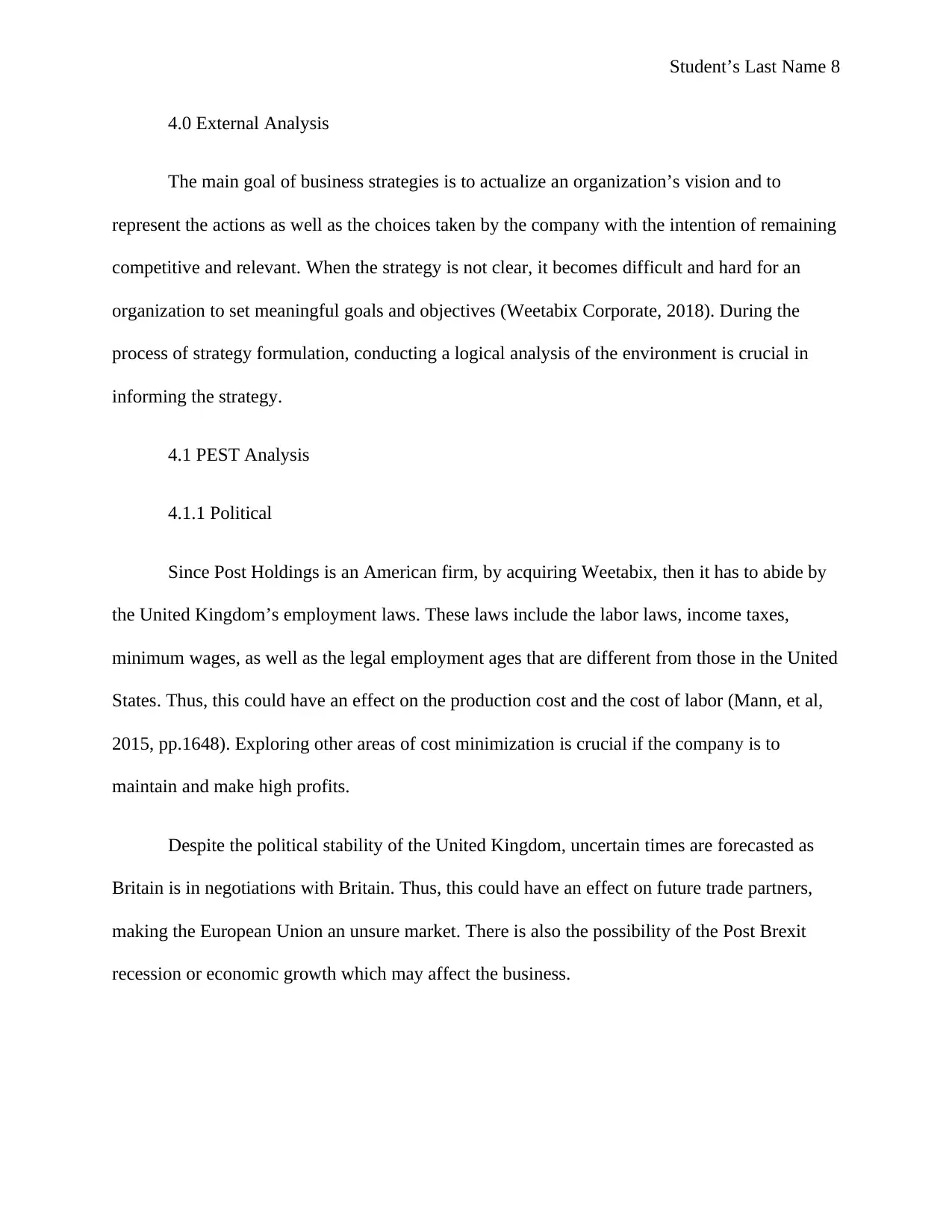
Student’s Last Name 8
4.0 External Analysis
The main goal of business strategies is to actualize an organization’s vision and to
represent the actions as well as the choices taken by the company with the intention of remaining
competitive and relevant. When the strategy is not clear, it becomes difficult and hard for an
organization to set meaningful goals and objectives (Weetabix Corporate, 2018). During the
process of strategy formulation, conducting a logical analysis of the environment is crucial in
informing the strategy.
4.1 PEST Analysis
4.1.1 Political
Since Post Holdings is an American firm, by acquiring Weetabix, then it has to abide by
the United Kingdom’s employment laws. These laws include the labor laws, income taxes,
minimum wages, as well as the legal employment ages that are different from those in the United
States. Thus, this could have an effect on the production cost and the cost of labor (Mann, et al,
2015, pp.1648). Exploring other areas of cost minimization is crucial if the company is to
maintain and make high profits.
Despite the political stability of the United Kingdom, uncertain times are forecasted as
Britain is in negotiations with Britain. Thus, this could have an effect on future trade partners,
making the European Union an unsure market. There is also the possibility of the Post Brexit
recession or economic growth which may affect the business.
4.0 External Analysis
The main goal of business strategies is to actualize an organization’s vision and to
represent the actions as well as the choices taken by the company with the intention of remaining
competitive and relevant. When the strategy is not clear, it becomes difficult and hard for an
organization to set meaningful goals and objectives (Weetabix Corporate, 2018). During the
process of strategy formulation, conducting a logical analysis of the environment is crucial in
informing the strategy.
4.1 PEST Analysis
4.1.1 Political
Since Post Holdings is an American firm, by acquiring Weetabix, then it has to abide by
the United Kingdom’s employment laws. These laws include the labor laws, income taxes,
minimum wages, as well as the legal employment ages that are different from those in the United
States. Thus, this could have an effect on the production cost and the cost of labor (Mann, et al,
2015, pp.1648). Exploring other areas of cost minimization is crucial if the company is to
maintain and make high profits.
Despite the political stability of the United Kingdom, uncertain times are forecasted as
Britain is in negotiations with Britain. Thus, this could have an effect on future trade partners,
making the European Union an unsure market. There is also the possibility of the Post Brexit
recession or economic growth which may affect the business.
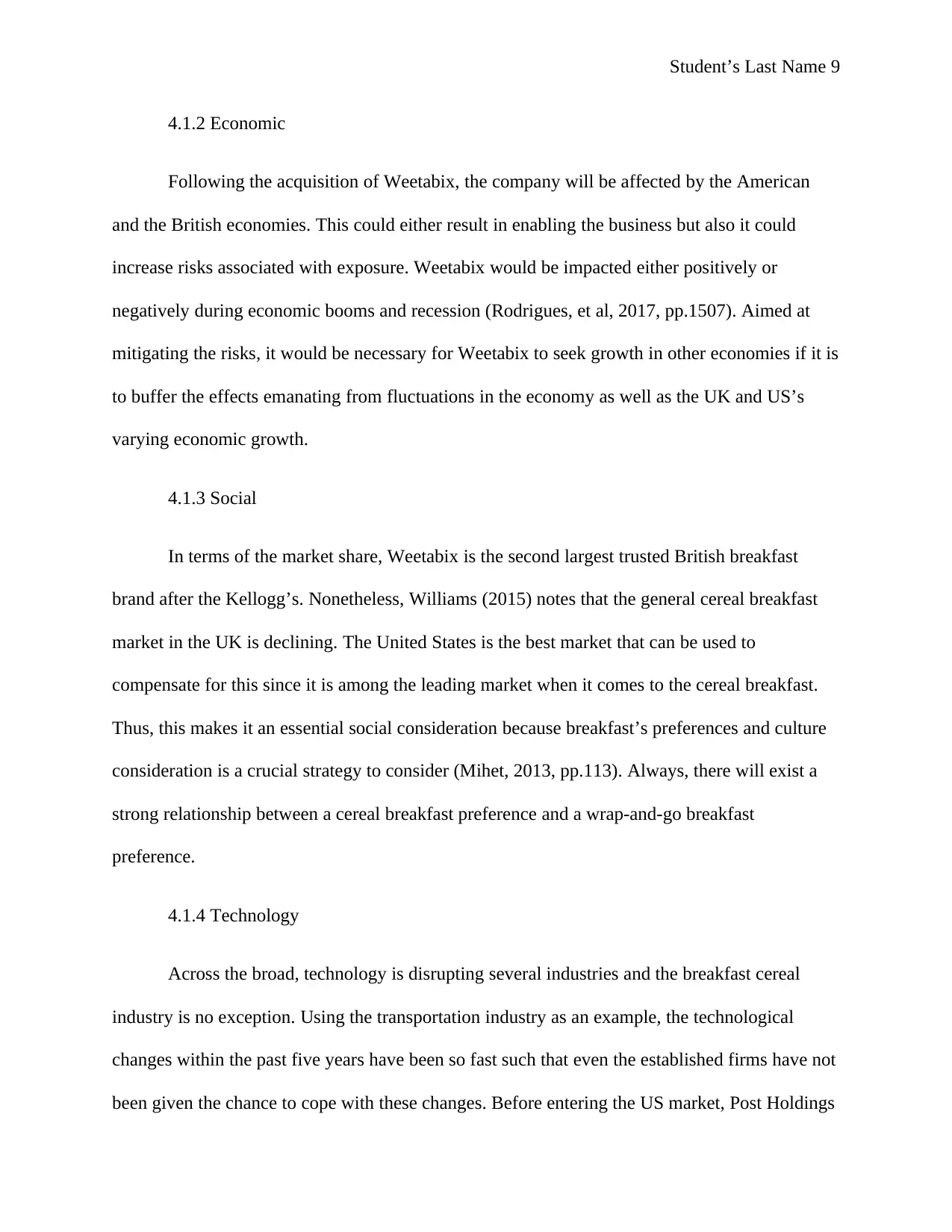
Student’s Last Name 9
4.1.2 Economic
Following the acquisition of Weetabix, the company will be affected by the American
and the British economies. This could either result in enabling the business but also it could
increase risks associated with exposure. Weetabix would be impacted either positively or
negatively during economic booms and recession (Rodrigues, et al, 2017, pp.1507). Aimed at
mitigating the risks, it would be necessary for Weetabix to seek growth in other economies if it is
to buffer the effects emanating from fluctuations in the economy as well as the UK and US’s
varying economic growth.
4.1.3 Social
In terms of the market share, Weetabix is the second largest trusted British breakfast
brand after the Kellogg’s. Nonetheless, Williams (2015) notes that the general cereal breakfast
market in the UK is declining. The United States is the best market that can be used to
compensate for this since it is among the leading market when it comes to the cereal breakfast.
Thus, this makes it an essential social consideration because breakfast’s preferences and culture
consideration is a crucial strategy to consider (Mihet, 2013, pp.113). Always, there will exist a
strong relationship between a cereal breakfast preference and a wrap-and-go breakfast
preference.
4.1.4 Technology
Across the broad, technology is disrupting several industries and the breakfast cereal
industry is no exception. Using the transportation industry as an example, the technological
changes within the past five years have been so fast such that even the established firms have not
been given the chance to cope with these changes. Before entering the US market, Post Holdings
4.1.2 Economic
Following the acquisition of Weetabix, the company will be affected by the American
and the British economies. This could either result in enabling the business but also it could
increase risks associated with exposure. Weetabix would be impacted either positively or
negatively during economic booms and recession (Rodrigues, et al, 2017, pp.1507). Aimed at
mitigating the risks, it would be necessary for Weetabix to seek growth in other economies if it is
to buffer the effects emanating from fluctuations in the economy as well as the UK and US’s
varying economic growth.
4.1.3 Social
In terms of the market share, Weetabix is the second largest trusted British breakfast
brand after the Kellogg’s. Nonetheless, Williams (2015) notes that the general cereal breakfast
market in the UK is declining. The United States is the best market that can be used to
compensate for this since it is among the leading market when it comes to the cereal breakfast.
Thus, this makes it an essential social consideration because breakfast’s preferences and culture
consideration is a crucial strategy to consider (Mihet, 2013, pp.113). Always, there will exist a
strong relationship between a cereal breakfast preference and a wrap-and-go breakfast
preference.
4.1.4 Technology
Across the broad, technology is disrupting several industries and the breakfast cereal
industry is no exception. Using the transportation industry as an example, the technological
changes within the past five years have been so fast such that even the established firms have not
been given the chance to cope with these changes. Before entering the US market, Post Holdings
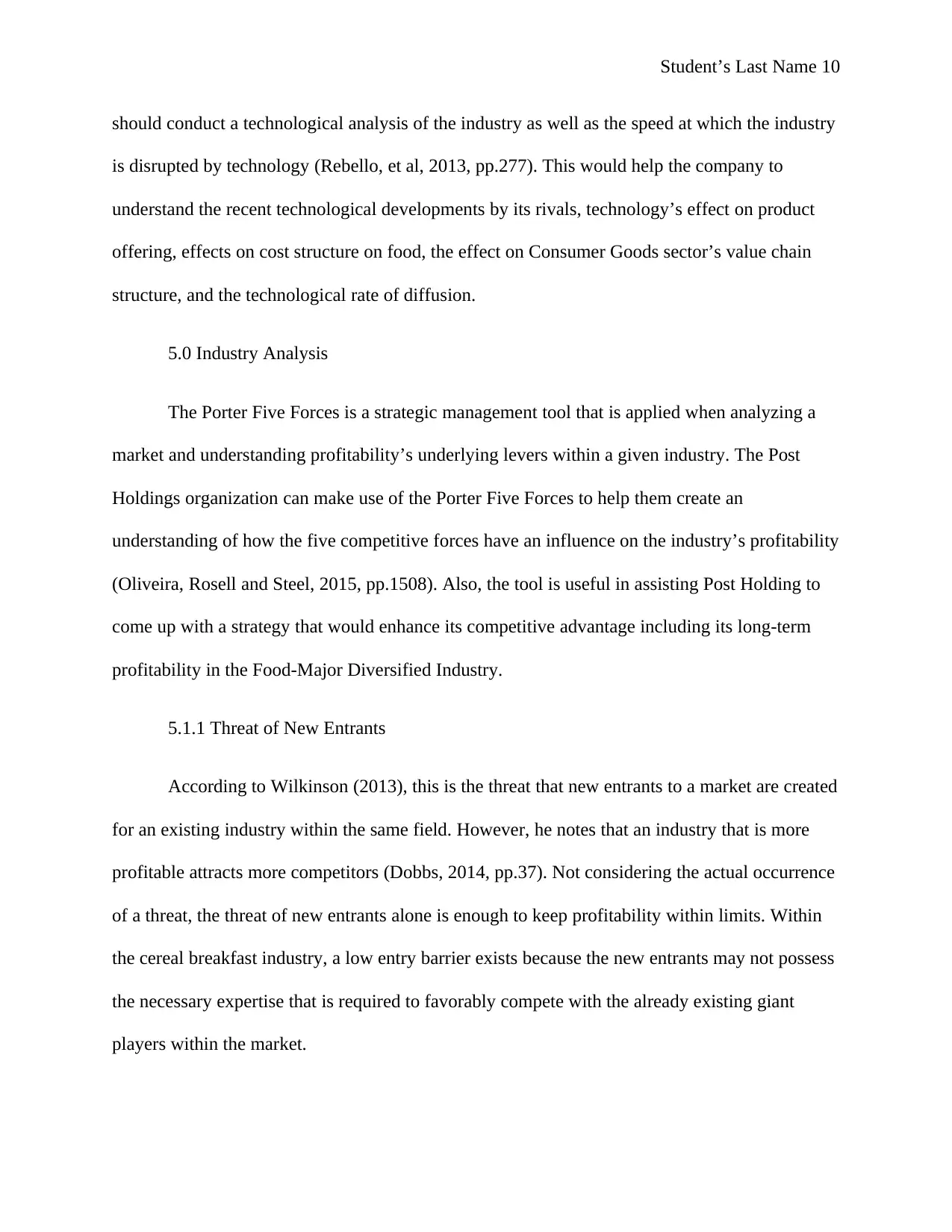
Student’s Last Name 10
should conduct a technological analysis of the industry as well as the speed at which the industry
is disrupted by technology (Rebello, et al, 2013, pp.277). This would help the company to
understand the recent technological developments by its rivals, technology’s effect on product
offering, effects on cost structure on food, the effect on Consumer Goods sector’s value chain
structure, and the technological rate of diffusion.
5.0 Industry Analysis
The Porter Five Forces is a strategic management tool that is applied when analyzing a
market and understanding profitability’s underlying levers within a given industry. The Post
Holdings organization can make use of the Porter Five Forces to help them create an
understanding of how the five competitive forces have an influence on the industry’s profitability
(Oliveira, Rosell and Steel, 2015, pp.1508). Also, the tool is useful in assisting Post Holding to
come up with a strategy that would enhance its competitive advantage including its long-term
profitability in the Food-Major Diversified Industry.
5.1.1 Threat of New Entrants
According to Wilkinson (2013), this is the threat that new entrants to a market are created
for an existing industry within the same field. However, he notes that an industry that is more
profitable attracts more competitors (Dobbs, 2014, pp.37). Not considering the actual occurrence
of a threat, the threat of new entrants alone is enough to keep profitability within limits. Within
the cereal breakfast industry, a low entry barrier exists because the new entrants may not possess
the necessary expertise that is required to favorably compete with the already existing giant
players within the market.
should conduct a technological analysis of the industry as well as the speed at which the industry
is disrupted by technology (Rebello, et al, 2013, pp.277). This would help the company to
understand the recent technological developments by its rivals, technology’s effect on product
offering, effects on cost structure on food, the effect on Consumer Goods sector’s value chain
structure, and the technological rate of diffusion.
5.0 Industry Analysis
The Porter Five Forces is a strategic management tool that is applied when analyzing a
market and understanding profitability’s underlying levers within a given industry. The Post
Holdings organization can make use of the Porter Five Forces to help them create an
understanding of how the five competitive forces have an influence on the industry’s profitability
(Oliveira, Rosell and Steel, 2015, pp.1508). Also, the tool is useful in assisting Post Holding to
come up with a strategy that would enhance its competitive advantage including its long-term
profitability in the Food-Major Diversified Industry.
5.1.1 Threat of New Entrants
According to Wilkinson (2013), this is the threat that new entrants to a market are created
for an existing industry within the same field. However, he notes that an industry that is more
profitable attracts more competitors (Dobbs, 2014, pp.37). Not considering the actual occurrence
of a threat, the threat of new entrants alone is enough to keep profitability within limits. Within
the cereal breakfast industry, a low entry barrier exists because the new entrants may not possess
the necessary expertise that is required to favorably compete with the already existing giant
players within the market.
Secure Best Marks with AI Grader
Need help grading? Try our AI Grader for instant feedback on your assignments.
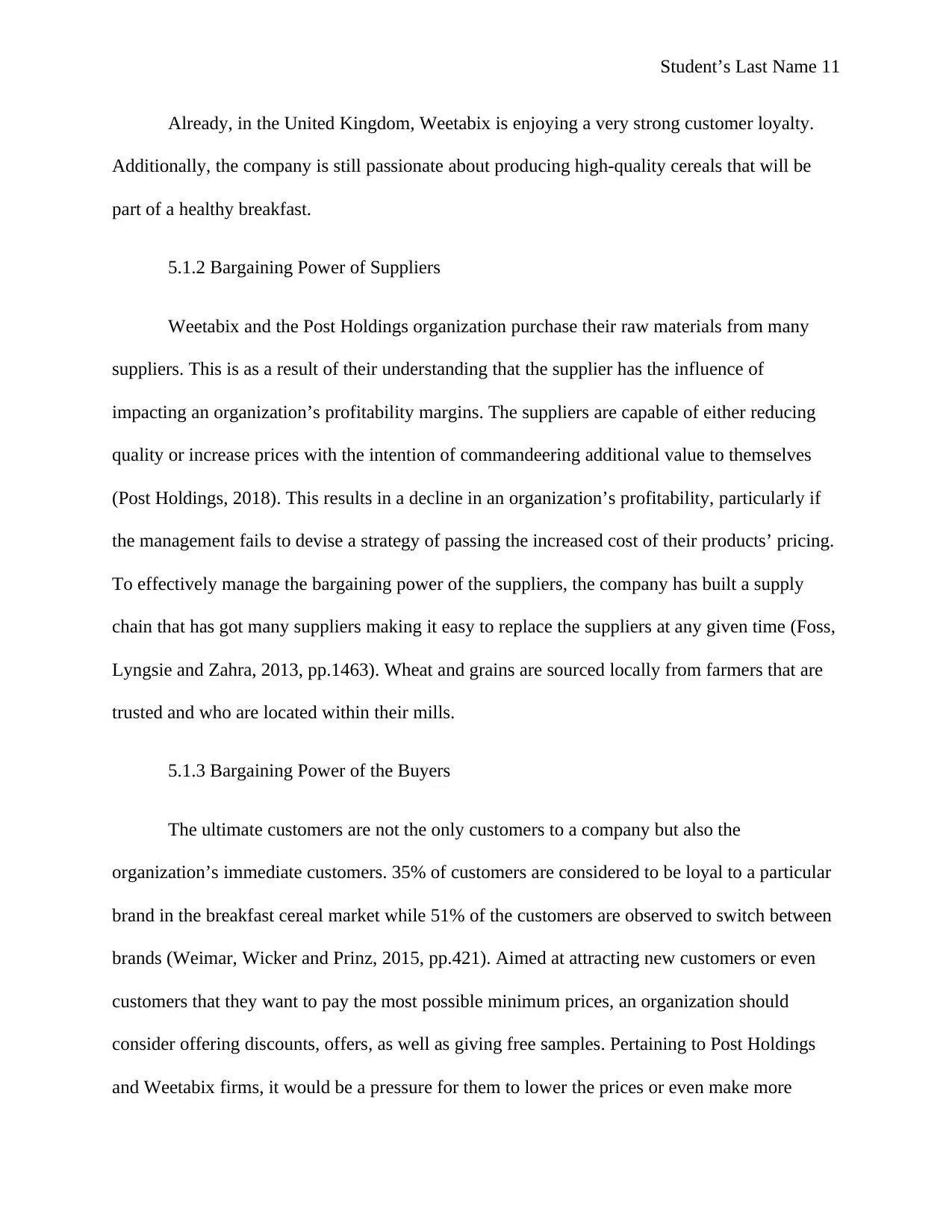
Student’s Last Name 11
Already, in the United Kingdom, Weetabix is enjoying a very strong customer loyalty.
Additionally, the company is still passionate about producing high-quality cereals that will be
part of a healthy breakfast.
5.1.2 Bargaining Power of Suppliers
Weetabix and the Post Holdings organization purchase their raw materials from many
suppliers. This is as a result of their understanding that the supplier has the influence of
impacting an organization’s profitability margins. The suppliers are capable of either reducing
quality or increase prices with the intention of commandeering additional value to themselves
(Post Holdings, 2018). This results in a decline in an organization’s profitability, particularly if
the management fails to devise a strategy of passing the increased cost of their products’ pricing.
To effectively manage the bargaining power of the suppliers, the company has built a supply
chain that has got many suppliers making it easy to replace the suppliers at any given time (Foss,
Lyngsie and Zahra, 2013, pp.1463). Wheat and grains are sourced locally from farmers that are
trusted and who are located within their mills.
5.1.3 Bargaining Power of the Buyers
The ultimate customers are not the only customers to a company but also the
organization’s immediate customers. 35% of customers are considered to be loyal to a particular
brand in the breakfast cereal market while 51% of the customers are observed to switch between
brands (Weimar, Wicker and Prinz, 2015, pp.421). Aimed at attracting new customers or even
customers that they want to pay the most possible minimum prices, an organization should
consider offering discounts, offers, as well as giving free samples. Pertaining to Post Holdings
and Weetabix firms, it would be a pressure for them to lower the prices or even make more
Already, in the United Kingdom, Weetabix is enjoying a very strong customer loyalty.
Additionally, the company is still passionate about producing high-quality cereals that will be
part of a healthy breakfast.
5.1.2 Bargaining Power of Suppliers
Weetabix and the Post Holdings organization purchase their raw materials from many
suppliers. This is as a result of their understanding that the supplier has the influence of
impacting an organization’s profitability margins. The suppliers are capable of either reducing
quality or increase prices with the intention of commandeering additional value to themselves
(Post Holdings, 2018). This results in a decline in an organization’s profitability, particularly if
the management fails to devise a strategy of passing the increased cost of their products’ pricing.
To effectively manage the bargaining power of the suppliers, the company has built a supply
chain that has got many suppliers making it easy to replace the suppliers at any given time (Foss,
Lyngsie and Zahra, 2013, pp.1463). Wheat and grains are sourced locally from farmers that are
trusted and who are located within their mills.
5.1.3 Bargaining Power of the Buyers
The ultimate customers are not the only customers to a company but also the
organization’s immediate customers. 35% of customers are considered to be loyal to a particular
brand in the breakfast cereal market while 51% of the customers are observed to switch between
brands (Weimar, Wicker and Prinz, 2015, pp.421). Aimed at attracting new customers or even
customers that they want to pay the most possible minimum prices, an organization should
consider offering discounts, offers, as well as giving free samples. Pertaining to Post Holdings
and Weetabix firms, it would be a pressure for them to lower the prices or even make more
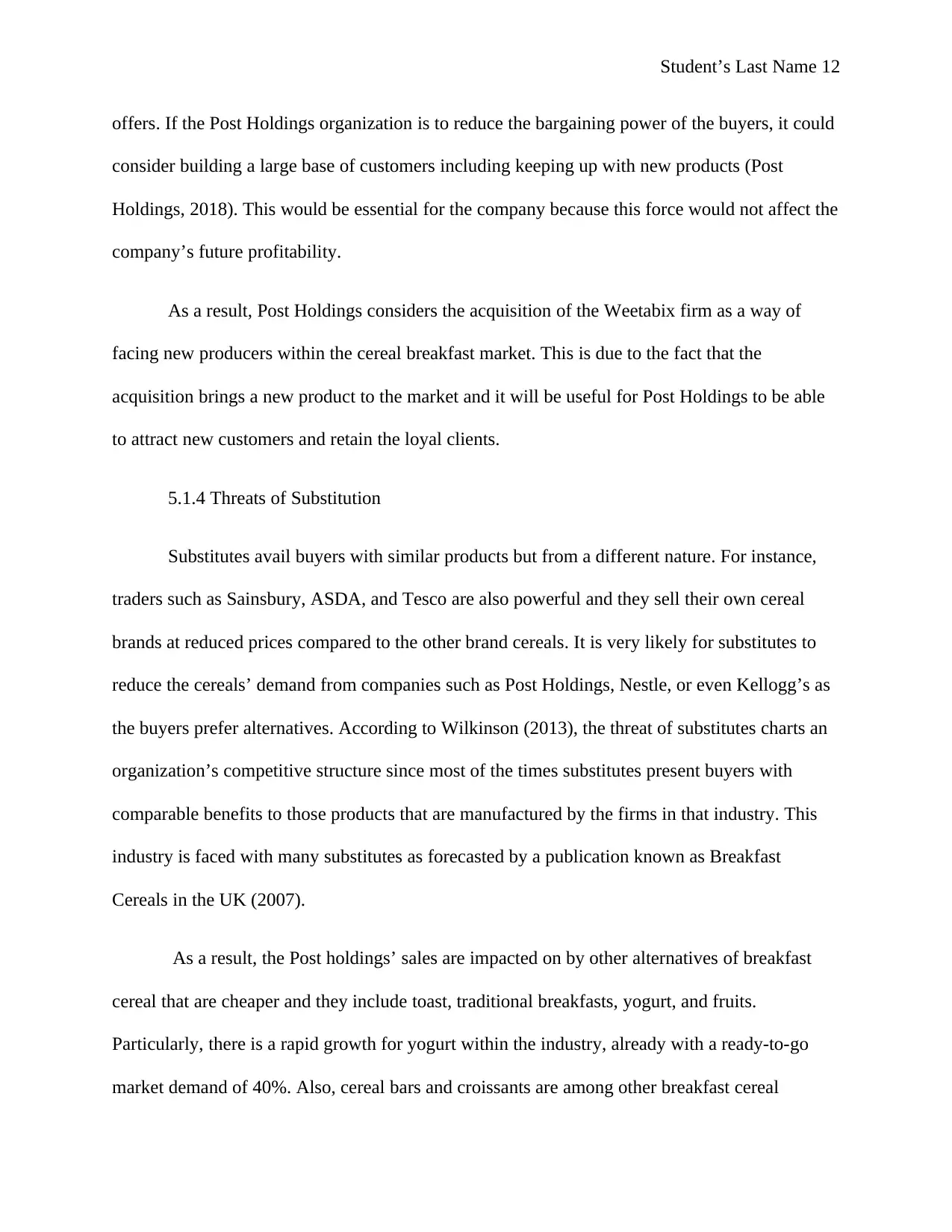
Student’s Last Name 12
offers. If the Post Holdings organization is to reduce the bargaining power of the buyers, it could
consider building a large base of customers including keeping up with new products (Post
Holdings, 2018). This would be essential for the company because this force would not affect the
company’s future profitability.
As a result, Post Holdings considers the acquisition of the Weetabix firm as a way of
facing new producers within the cereal breakfast market. This is due to the fact that the
acquisition brings a new product to the market and it will be useful for Post Holdings to be able
to attract new customers and retain the loyal clients.
5.1.4 Threats of Substitution
Substitutes avail buyers with similar products but from a different nature. For instance,
traders such as Sainsbury, ASDA, and Tesco are also powerful and they sell their own cereal
brands at reduced prices compared to the other brand cereals. It is very likely for substitutes to
reduce the cereals’ demand from companies such as Post Holdings, Nestle, or even Kellogg’s as
the buyers prefer alternatives. According to Wilkinson (2013), the threat of substitutes charts an
organization’s competitive structure since most of the times substitutes present buyers with
comparable benefits to those products that are manufactured by the firms in that industry. This
industry is faced with many substitutes as forecasted by a publication known as Breakfast
Cereals in the UK (2007).
As a result, the Post holdings’ sales are impacted on by other alternatives of breakfast
cereal that are cheaper and they include toast, traditional breakfasts, yogurt, and fruits.
Particularly, there is a rapid growth for yogurt within the industry, already with a ready-to-go
market demand of 40%. Also, cereal bars and croissants are among other breakfast cereal
offers. If the Post Holdings organization is to reduce the bargaining power of the buyers, it could
consider building a large base of customers including keeping up with new products (Post
Holdings, 2018). This would be essential for the company because this force would not affect the
company’s future profitability.
As a result, Post Holdings considers the acquisition of the Weetabix firm as a way of
facing new producers within the cereal breakfast market. This is due to the fact that the
acquisition brings a new product to the market and it will be useful for Post Holdings to be able
to attract new customers and retain the loyal clients.
5.1.4 Threats of Substitution
Substitutes avail buyers with similar products but from a different nature. For instance,
traders such as Sainsbury, ASDA, and Tesco are also powerful and they sell their own cereal
brands at reduced prices compared to the other brand cereals. It is very likely for substitutes to
reduce the cereals’ demand from companies such as Post Holdings, Nestle, or even Kellogg’s as
the buyers prefer alternatives. According to Wilkinson (2013), the threat of substitutes charts an
organization’s competitive structure since most of the times substitutes present buyers with
comparable benefits to those products that are manufactured by the firms in that industry. This
industry is faced with many substitutes as forecasted by a publication known as Breakfast
Cereals in the UK (2007).
As a result, the Post holdings’ sales are impacted on by other alternatives of breakfast
cereal that are cheaper and they include toast, traditional breakfasts, yogurt, and fruits.
Particularly, there is a rapid growth for yogurt within the industry, already with a ready-to-go
market demand of 40%. Also, cereal bars and croissants are among other breakfast cereal
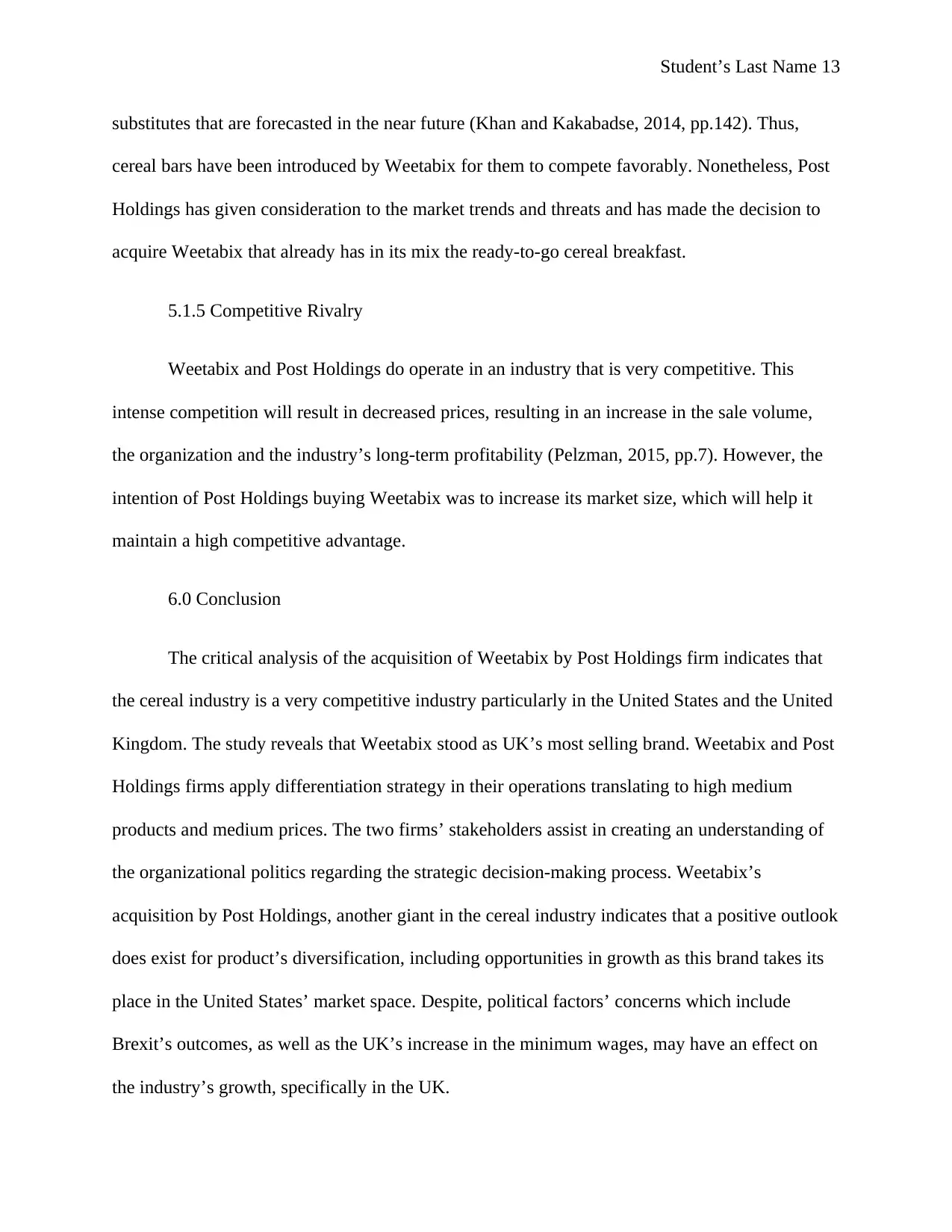
Student’s Last Name 13
substitutes that are forecasted in the near future (Khan and Kakabadse, 2014, pp.142). Thus,
cereal bars have been introduced by Weetabix for them to compete favorably. Nonetheless, Post
Holdings has given consideration to the market trends and threats and has made the decision to
acquire Weetabix that already has in its mix the ready-to-go cereal breakfast.
5.1.5 Competitive Rivalry
Weetabix and Post Holdings do operate in an industry that is very competitive. This
intense competition will result in decreased prices, resulting in an increase in the sale volume,
the organization and the industry’s long-term profitability (Pelzman, 2015, pp.7). However, the
intention of Post Holdings buying Weetabix was to increase its market size, which will help it
maintain a high competitive advantage.
6.0 Conclusion
The critical analysis of the acquisition of Weetabix by Post Holdings firm indicates that
the cereal industry is a very competitive industry particularly in the United States and the United
Kingdom. The study reveals that Weetabix stood as UK’s most selling brand. Weetabix and Post
Holdings firms apply differentiation strategy in their operations translating to high medium
products and medium prices. The two firms’ stakeholders assist in creating an understanding of
the organizational politics regarding the strategic decision-making process. Weetabix’s
acquisition by Post Holdings, another giant in the cereal industry indicates that a positive outlook
does exist for product’s diversification, including opportunities in growth as this brand takes its
place in the United States’ market space. Despite, political factors’ concerns which include
Brexit’s outcomes, as well as the UK’s increase in the minimum wages, may have an effect on
the industry’s growth, specifically in the UK.
substitutes that are forecasted in the near future (Khan and Kakabadse, 2014, pp.142). Thus,
cereal bars have been introduced by Weetabix for them to compete favorably. Nonetheless, Post
Holdings has given consideration to the market trends and threats and has made the decision to
acquire Weetabix that already has in its mix the ready-to-go cereal breakfast.
5.1.5 Competitive Rivalry
Weetabix and Post Holdings do operate in an industry that is very competitive. This
intense competition will result in decreased prices, resulting in an increase in the sale volume,
the organization and the industry’s long-term profitability (Pelzman, 2015, pp.7). However, the
intention of Post Holdings buying Weetabix was to increase its market size, which will help it
maintain a high competitive advantage.
6.0 Conclusion
The critical analysis of the acquisition of Weetabix by Post Holdings firm indicates that
the cereal industry is a very competitive industry particularly in the United States and the United
Kingdom. The study reveals that Weetabix stood as UK’s most selling brand. Weetabix and Post
Holdings firms apply differentiation strategy in their operations translating to high medium
products and medium prices. The two firms’ stakeholders assist in creating an understanding of
the organizational politics regarding the strategic decision-making process. Weetabix’s
acquisition by Post Holdings, another giant in the cereal industry indicates that a positive outlook
does exist for product’s diversification, including opportunities in growth as this brand takes its
place in the United States’ market space. Despite, political factors’ concerns which include
Brexit’s outcomes, as well as the UK’s increase in the minimum wages, may have an effect on
the industry’s growth, specifically in the UK.
Paraphrase This Document
Need a fresh take? Get an instant paraphrase of this document with our AI Paraphraser
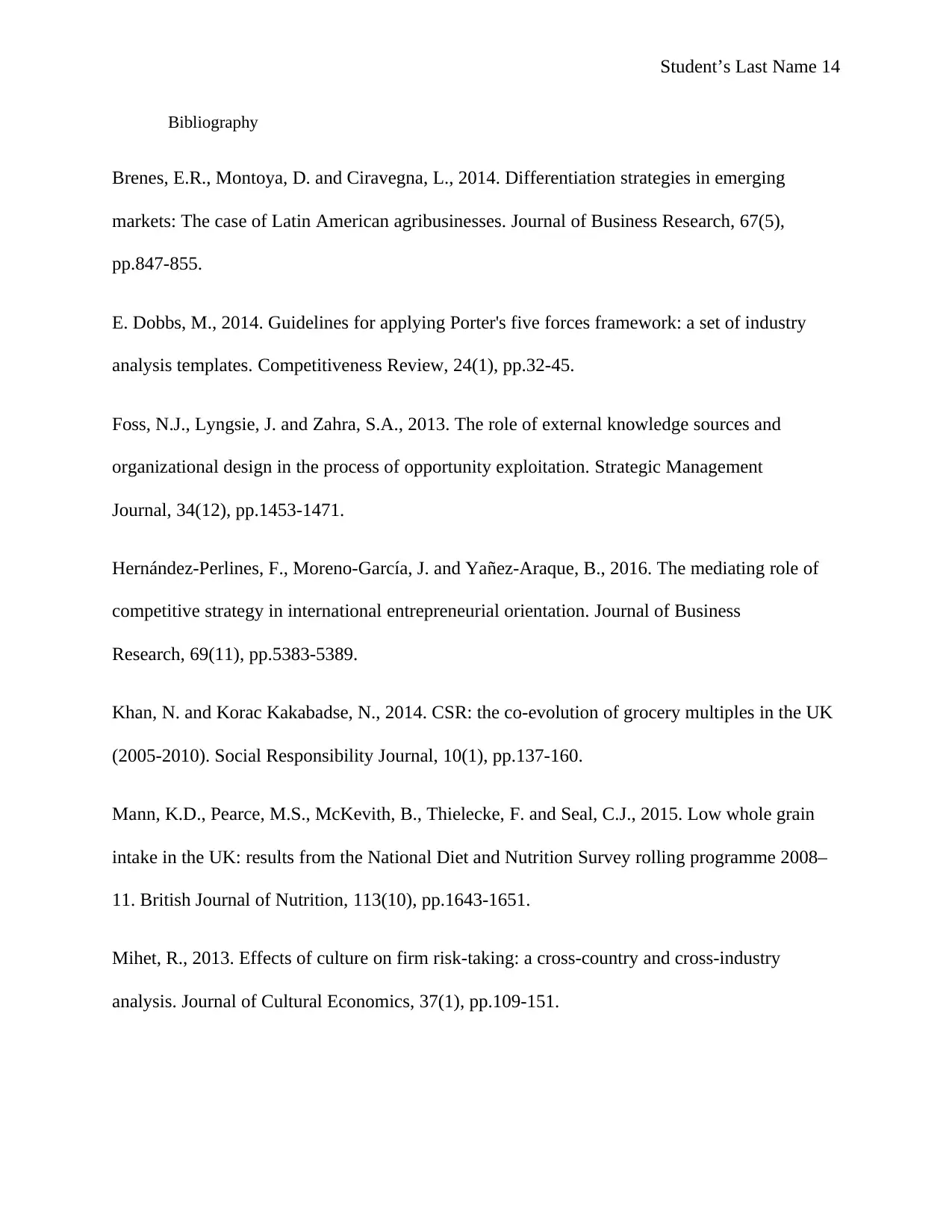
Student’s Last Name 14
Bibliography
Brenes, E.R., Montoya, D. and Ciravegna, L., 2014. Differentiation strategies in emerging
markets: The case of Latin American agribusinesses. Journal of Business Research, 67(5),
pp.847-855.
E. Dobbs, M., 2014. Guidelines for applying Porter's five forces framework: a set of industry
analysis templates. Competitiveness Review, 24(1), pp.32-45.
Foss, N.J., Lyngsie, J. and Zahra, S.A., 2013. The role of external knowledge sources and
organizational design in the process of opportunity exploitation. Strategic Management
Journal, 34(12), pp.1453-1471.
Hernández-Perlines, F., Moreno-García, J. and Yañez-Araque, B., 2016. The mediating role of
competitive strategy in international entrepreneurial orientation. Journal of Business
Research, 69(11), pp.5383-5389.
Khan, N. and Korac Kakabadse, N., 2014. CSR: the co-evolution of grocery multiples in the UK
(2005-2010). Social Responsibility Journal, 10(1), pp.137-160.
Mann, K.D., Pearce, M.S., McKevith, B., Thielecke, F. and Seal, C.J., 2015. Low whole grain
intake in the UK: results from the National Diet and Nutrition Survey rolling programme 2008–
11. British Journal of Nutrition, 113(10), pp.1643-1651.
Mihet, R., 2013. Effects of culture on firm risk-taking: a cross-country and cross-industry
analysis. Journal of Cultural Economics, 37(1), pp.109-151.
Bibliography
Brenes, E.R., Montoya, D. and Ciravegna, L., 2014. Differentiation strategies in emerging
markets: The case of Latin American agribusinesses. Journal of Business Research, 67(5),
pp.847-855.
E. Dobbs, M., 2014. Guidelines for applying Porter's five forces framework: a set of industry
analysis templates. Competitiveness Review, 24(1), pp.32-45.
Foss, N.J., Lyngsie, J. and Zahra, S.A., 2013. The role of external knowledge sources and
organizational design in the process of opportunity exploitation. Strategic Management
Journal, 34(12), pp.1453-1471.
Hernández-Perlines, F., Moreno-García, J. and Yañez-Araque, B., 2016. The mediating role of
competitive strategy in international entrepreneurial orientation. Journal of Business
Research, 69(11), pp.5383-5389.
Khan, N. and Korac Kakabadse, N., 2014. CSR: the co-evolution of grocery multiples in the UK
(2005-2010). Social Responsibility Journal, 10(1), pp.137-160.
Mann, K.D., Pearce, M.S., McKevith, B., Thielecke, F. and Seal, C.J., 2015. Low whole grain
intake in the UK: results from the National Diet and Nutrition Survey rolling programme 2008–
11. British Journal of Nutrition, 113(10), pp.1643-1651.
Mihet, R., 2013. Effects of culture on firm risk-taking: a cross-country and cross-industry
analysis. Journal of Cultural Economics, 37(1), pp.109-151.
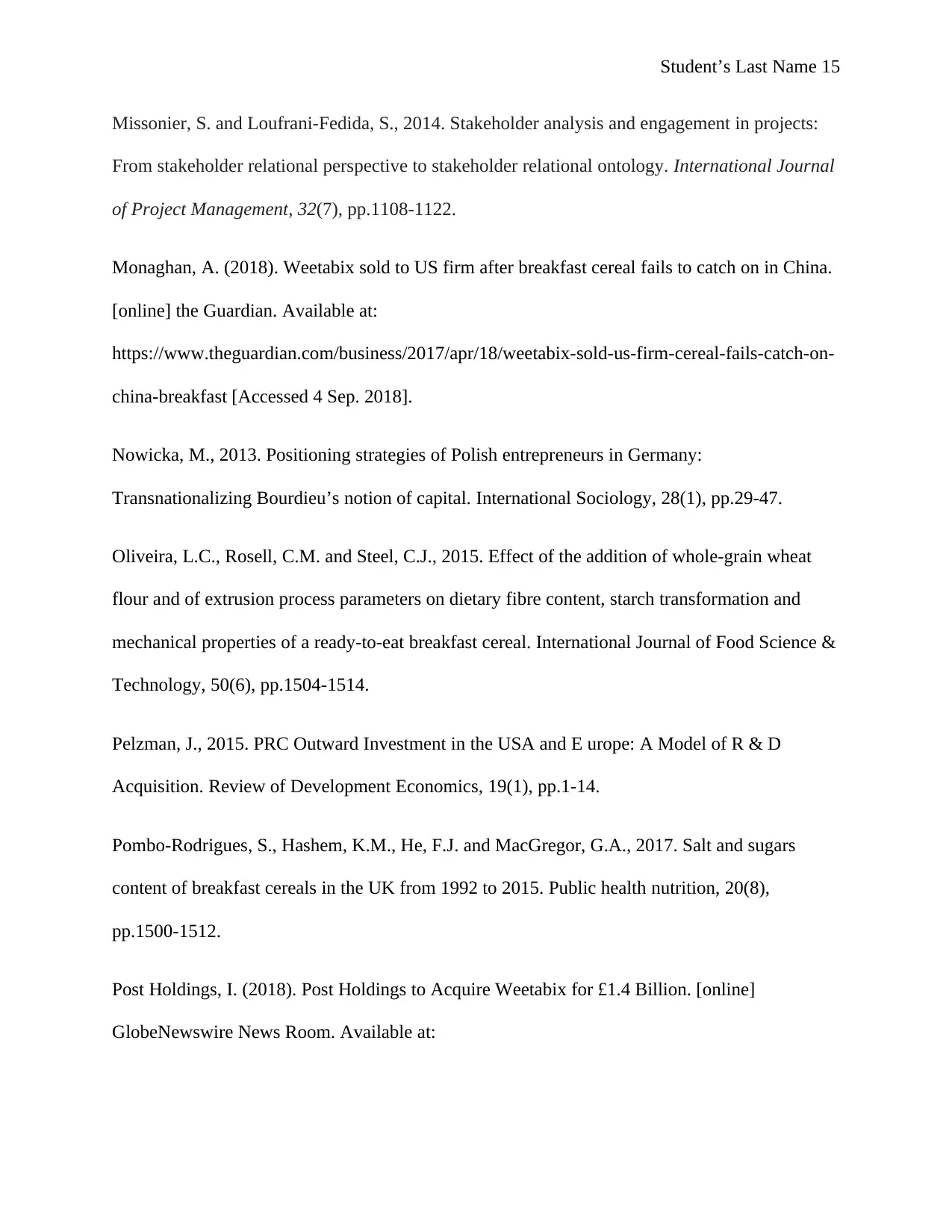
Student’s Last Name 15
Missonier, S. and Loufrani-Fedida, S., 2014. Stakeholder analysis and engagement in projects:
From stakeholder relational perspective to stakeholder relational ontology. International Journal
of Project Management, 32(7), pp.1108-1122.
Monaghan, A. (2018). Weetabix sold to US firm after breakfast cereal fails to catch on in China.
[online] the Guardian. Available at:
https://www.theguardian.com/business/2017/apr/18/weetabix-sold-us-firm-cereal-fails-catch-on-
china-breakfast [Accessed 4 Sep. 2018].
Nowicka, M., 2013. Positioning strategies of Polish entrepreneurs in Germany:
Transnationalizing Bourdieu’s notion of capital. International Sociology, 28(1), pp.29-47.
Oliveira, L.C., Rosell, C.M. and Steel, C.J., 2015. Effect of the addition of whole‐grain wheat
flour and of extrusion process parameters on dietary fibre content, starch transformation and
mechanical properties of a ready‐to‐eat breakfast cereal. International Journal of Food Science &
Technology, 50(6), pp.1504-1514.
Pelzman, J., 2015. PRC Outward Investment in the USA and E urope: A Model of R & D
Acquisition. Review of Development Economics, 19(1), pp.1-14.
Pombo-Rodrigues, S., Hashem, K.M., He, F.J. and MacGregor, G.A., 2017. Salt and sugars
content of breakfast cereals in the UK from 1992 to 2015. Public health nutrition, 20(8),
pp.1500-1512.
Post Holdings, I. (2018). Post Holdings to Acquire Weetabix for £1.4 Billion. [online]
GlobeNewswire News Room. Available at:
Missonier, S. and Loufrani-Fedida, S., 2014. Stakeholder analysis and engagement in projects:
From stakeholder relational perspective to stakeholder relational ontology. International Journal
of Project Management, 32(7), pp.1108-1122.
Monaghan, A. (2018). Weetabix sold to US firm after breakfast cereal fails to catch on in China.
[online] the Guardian. Available at:
https://www.theguardian.com/business/2017/apr/18/weetabix-sold-us-firm-cereal-fails-catch-on-
china-breakfast [Accessed 4 Sep. 2018].
Nowicka, M., 2013. Positioning strategies of Polish entrepreneurs in Germany:
Transnationalizing Bourdieu’s notion of capital. International Sociology, 28(1), pp.29-47.
Oliveira, L.C., Rosell, C.M. and Steel, C.J., 2015. Effect of the addition of whole‐grain wheat
flour and of extrusion process parameters on dietary fibre content, starch transformation and
mechanical properties of a ready‐to‐eat breakfast cereal. International Journal of Food Science &
Technology, 50(6), pp.1504-1514.
Pelzman, J., 2015. PRC Outward Investment in the USA and E urope: A Model of R & D
Acquisition. Review of Development Economics, 19(1), pp.1-14.
Pombo-Rodrigues, S., Hashem, K.M., He, F.J. and MacGregor, G.A., 2017. Salt and sugars
content of breakfast cereals in the UK from 1992 to 2015. Public health nutrition, 20(8),
pp.1500-1512.
Post Holdings, I. (2018). Post Holdings to Acquire Weetabix for £1.4 Billion. [online]
GlobeNewswire News Room. Available at:
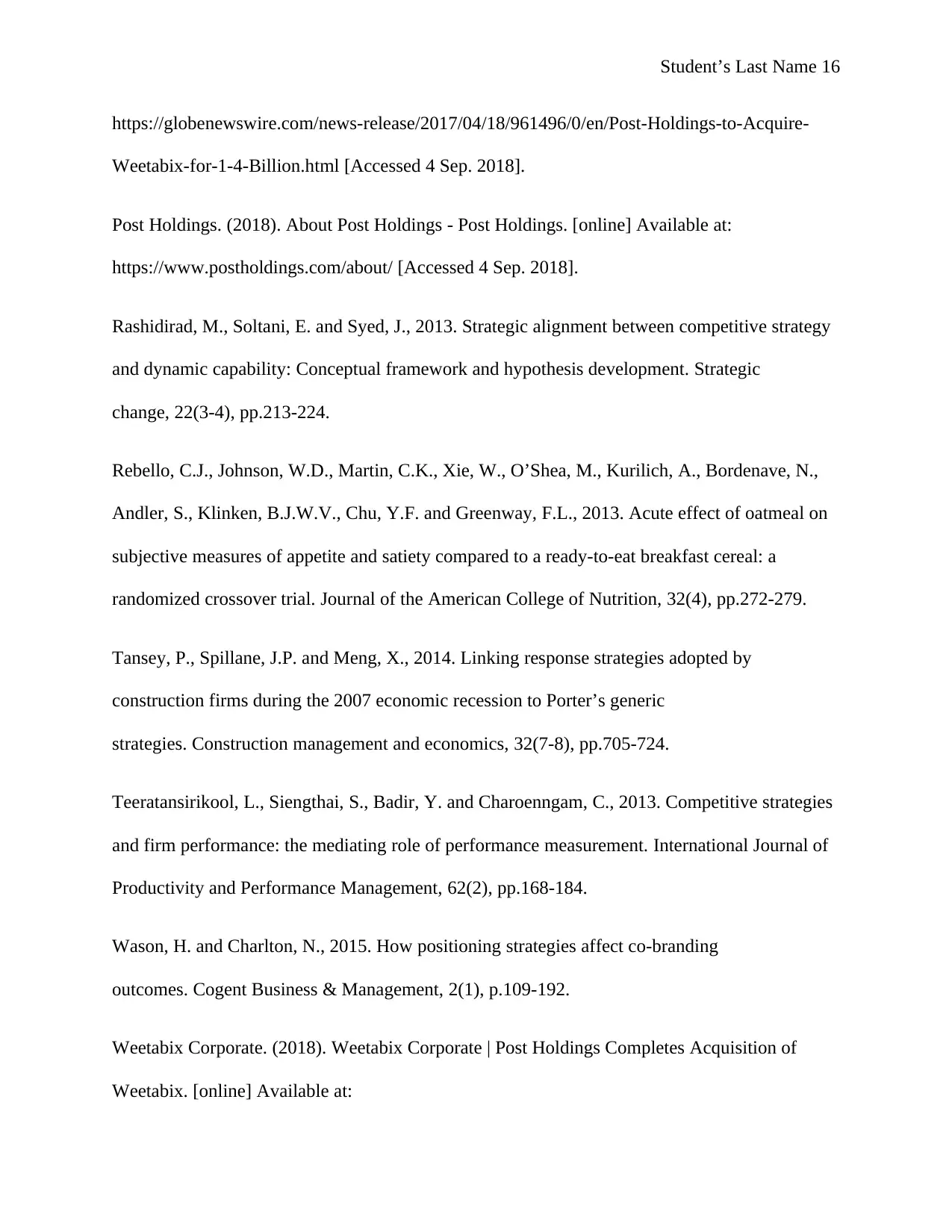
Student’s Last Name 16
https://globenewswire.com/news-release/2017/04/18/961496/0/en/Post-Holdings-to-Acquire-
Weetabix-for-1-4-Billion.html [Accessed 4 Sep. 2018].
Post Holdings. (2018). About Post Holdings - Post Holdings. [online] Available at:
https://www.postholdings.com/about/ [Accessed 4 Sep. 2018].
Rashidirad, M., Soltani, E. and Syed, J., 2013. Strategic alignment between competitive strategy
and dynamic capability: Conceptual framework and hypothesis development. Strategic
change, 22(3‐4), pp.213-224.
Rebello, C.J., Johnson, W.D., Martin, C.K., Xie, W., O’Shea, M., Kurilich, A., Bordenave, N.,
Andler, S., Klinken, B.J.W.V., Chu, Y.F. and Greenway, F.L., 2013. Acute effect of oatmeal on
subjective measures of appetite and satiety compared to a ready-to-eat breakfast cereal: a
randomized crossover trial. Journal of the American College of Nutrition, 32(4), pp.272-279.
Tansey, P., Spillane, J.P. and Meng, X., 2014. Linking response strategies adopted by
construction firms during the 2007 economic recession to Porter’s generic
strategies. Construction management and economics, 32(7-8), pp.705-724.
Teeratansirikool, L., Siengthai, S., Badir, Y. and Charoenngam, C., 2013. Competitive strategies
and firm performance: the mediating role of performance measurement. International Journal of
Productivity and Performance Management, 62(2), pp.168-184.
Wason, H. and Charlton, N., 2015. How positioning strategies affect co-branding
outcomes. Cogent Business & Management, 2(1), p.109-192.
Weetabix Corporate. (2018). Weetabix Corporate | Post Holdings Completes Acquisition of
Weetabix. [online] Available at:
https://globenewswire.com/news-release/2017/04/18/961496/0/en/Post-Holdings-to-Acquire-
Weetabix-for-1-4-Billion.html [Accessed 4 Sep. 2018].
Post Holdings. (2018). About Post Holdings - Post Holdings. [online] Available at:
https://www.postholdings.com/about/ [Accessed 4 Sep. 2018].
Rashidirad, M., Soltani, E. and Syed, J., 2013. Strategic alignment between competitive strategy
and dynamic capability: Conceptual framework and hypothesis development. Strategic
change, 22(3‐4), pp.213-224.
Rebello, C.J., Johnson, W.D., Martin, C.K., Xie, W., O’Shea, M., Kurilich, A., Bordenave, N.,
Andler, S., Klinken, B.J.W.V., Chu, Y.F. and Greenway, F.L., 2013. Acute effect of oatmeal on
subjective measures of appetite and satiety compared to a ready-to-eat breakfast cereal: a
randomized crossover trial. Journal of the American College of Nutrition, 32(4), pp.272-279.
Tansey, P., Spillane, J.P. and Meng, X., 2014. Linking response strategies adopted by
construction firms during the 2007 economic recession to Porter’s generic
strategies. Construction management and economics, 32(7-8), pp.705-724.
Teeratansirikool, L., Siengthai, S., Badir, Y. and Charoenngam, C., 2013. Competitive strategies
and firm performance: the mediating role of performance measurement. International Journal of
Productivity and Performance Management, 62(2), pp.168-184.
Wason, H. and Charlton, N., 2015. How positioning strategies affect co-branding
outcomes. Cogent Business & Management, 2(1), p.109-192.
Weetabix Corporate. (2018). Weetabix Corporate | Post Holdings Completes Acquisition of
Weetabix. [online] Available at:
Secure Best Marks with AI Grader
Need help grading? Try our AI Grader for instant feedback on your assignments.
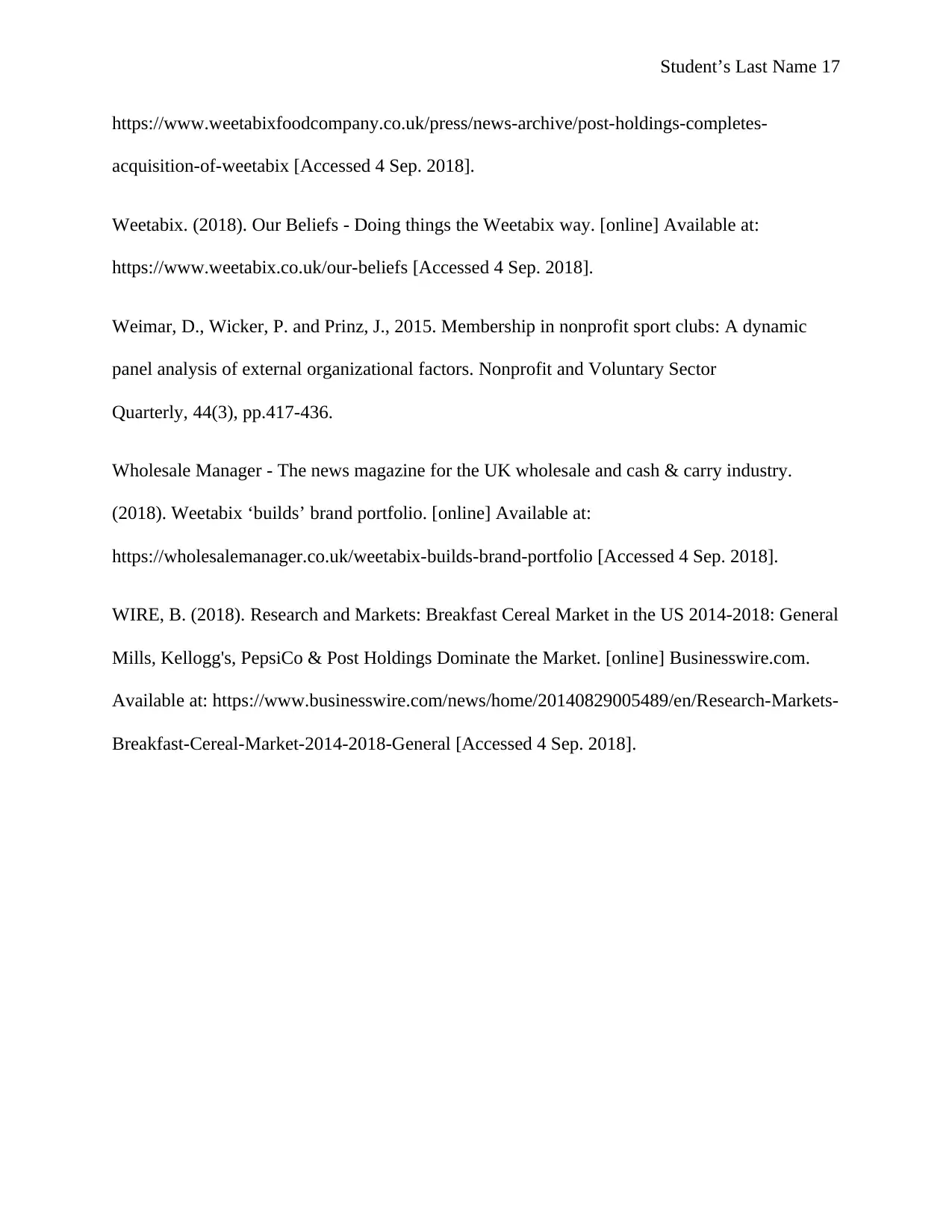
Student’s Last Name 17
https://www.weetabixfoodcompany.co.uk/press/news-archive/post-holdings-completes-
acquisition-of-weetabix [Accessed 4 Sep. 2018].
Weetabix. (2018). Our Beliefs - Doing things the Weetabix way. [online] Available at:
https://www.weetabix.co.uk/our-beliefs [Accessed 4 Sep. 2018].
Weimar, D., Wicker, P. and Prinz, J., 2015. Membership in nonprofit sport clubs: A dynamic
panel analysis of external organizational factors. Nonprofit and Voluntary Sector
Quarterly, 44(3), pp.417-436.
Wholesale Manager - The news magazine for the UK wholesale and cash & carry industry.
(2018). Weetabix ‘builds’ brand portfolio. [online] Available at:
https://wholesalemanager.co.uk/weetabix-builds-brand-portfolio [Accessed 4 Sep. 2018].
WIRE, B. (2018). Research and Markets: Breakfast Cereal Market in the US 2014-2018: General
Mills, Kellogg's, PepsiCo & Post Holdings Dominate the Market. [online] Businesswire.com.
Available at: https://www.businesswire.com/news/home/20140829005489/en/Research-Markets-
Breakfast-Cereal-Market-2014-2018-General [Accessed 4 Sep. 2018].
https://www.weetabixfoodcompany.co.uk/press/news-archive/post-holdings-completes-
acquisition-of-weetabix [Accessed 4 Sep. 2018].
Weetabix. (2018). Our Beliefs - Doing things the Weetabix way. [online] Available at:
https://www.weetabix.co.uk/our-beliefs [Accessed 4 Sep. 2018].
Weimar, D., Wicker, P. and Prinz, J., 2015. Membership in nonprofit sport clubs: A dynamic
panel analysis of external organizational factors. Nonprofit and Voluntary Sector
Quarterly, 44(3), pp.417-436.
Wholesale Manager - The news magazine for the UK wholesale and cash & carry industry.
(2018). Weetabix ‘builds’ brand portfolio. [online] Available at:
https://wholesalemanager.co.uk/weetabix-builds-brand-portfolio [Accessed 4 Sep. 2018].
WIRE, B. (2018). Research and Markets: Breakfast Cereal Market in the US 2014-2018: General
Mills, Kellogg's, PepsiCo & Post Holdings Dominate the Market. [online] Businesswire.com.
Available at: https://www.businesswire.com/news/home/20140829005489/en/Research-Markets-
Breakfast-Cereal-Market-2014-2018-General [Accessed 4 Sep. 2018].
1 out of 17
Your All-in-One AI-Powered Toolkit for Academic Success.
+13062052269
info@desklib.com
Available 24*7 on WhatsApp / Email
![[object Object]](/_next/static/media/star-bottom.7253800d.svg)
Unlock your academic potential
© 2024 | Zucol Services PVT LTD | All rights reserved.



